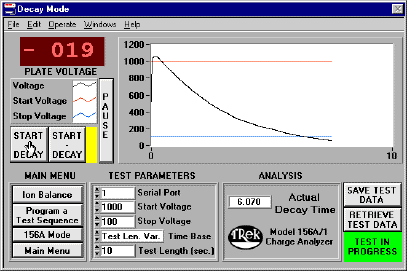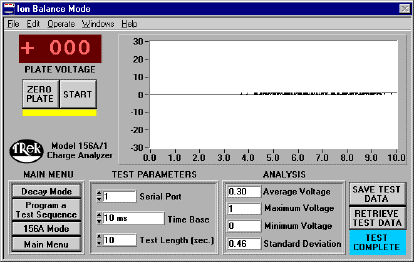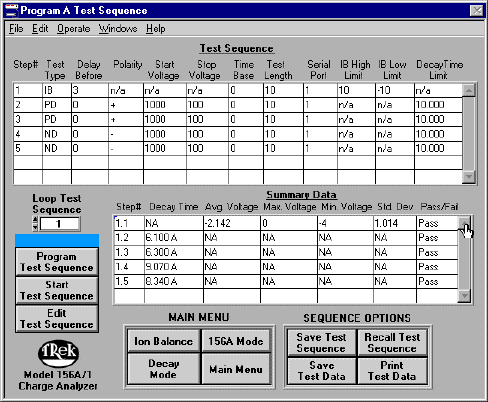Is your ionizer
neutralizing charges
as quickly and completely as needed?
Is it balanced?
Can you evaluate your ionizers while they are
installed in production?
Is the recording of your ionizer test data
efficient and cost effective?
Use the Model 156A to verify that new ionizers meet your selection criteria.
When evaluating newly setup or active ionizer installations, use the Model 156A to
determine if the decay times and ion balance performance are satisfactory for your
application.
Use the compact and portable Model 156A to determine when an ionizer needs maintenance.
The Model 156A Charged-Plate Monitor is an important tool for evaluating the performance
of the air ionizers used to neutralize static charges.
Tailor the plate size and shape to fit your process
Adjustable START/STOP voltage thresholds for
testing very sensitive devices like MR heads
Automate time-consuming testing using computer interface and applications software
Program and Run a Series of Tests
TREK, INC.
11601 Maple Ridge Road
Medina, NY 14103 USA
Call: 1 800 FOR-TREK
Tel: (716) 798-3140
Fax: (716) 798-3106
E-Mail
sales@trekinc.com
Web
www.trekinc.com
|
|
Importance of
Ionization Monitoring The
Model 156A tests the efficiency of your ionizer’s ion production by timing how long
it takes air ions produced to discharge a floating plate that has been pre-charged to
either a positive or negative value. The Model 156A also tests the balance between
positive and negative air ions by measuring the offset voltage generated on a floating
plate due to an imbalance of positive and negative air ions impinging on the plate from
your ionizer.
Typically, as the ionizer ages, the rates of positive and negative air ion production
decline. Consequently, the time required for the ionizer to neutralize static charges
increases, and the balance of positive and negative air ions changes. The neutralization
(decay) time may become too long for the ionizer to fully neutralize charges that are
generated at a work location, or the ionizer may begin to charge objects that were
initially uncharged. By using the Model 156A to periodically measure the decay times and
the ion balance, the need for, and frequency of, ionizer preventative maintenance can be
easily determined.
Innovations in Charged-Plate Monitor Technology
The Model 156A uses an innovative
voltage-follower technique to provide accuracy, stability, and bandwidth that is
unavailable from charged-plate monitors using fieldmeter-based measurement methods.
Accuracy, stability, and low zero offset for balance measurements
Fieldmeter-based charged-plate monitors are only accurate to within a few volts. This
inaccuracy is becoming intolerable in many of today's applications, where ion balance is
critical. With Trek’s voltage-follower technique, the indicated voltage is within one
volt of the actual voltage on the ion collecting plate.
Fieldmeter-based charged-plate monitors also have limited bandwidth, preventing faithful
measurement of the ripple from AC ionizers. Trek’s voltage-follower technique has a
much higher bandwidth, faithfully revealing these AC signals on the ion collecting plate.
Trek’s voltage-follower technique provides virtually infinite impedance loading of
the ion collecting plate, while allowing the plate to be charged and monitored through the
same, small diameter cable. Therefore, the size and shape of the ion collecting plate and
the plate's capacitance to ground may be tailored to a particular requirement.
For example, the plate capacitance can be matched to the capacitance of a particular
ESD-sensitive device, or the plate dimensions can be made to permit placement of the plate
in a remote or restricted space. Or, for standard applications, the Model 156P-C150XC150
Ion Collecting Plate is designed with the shape and capacitance-to-ground as specified in
ANSI EOS/ESD S3.1.
Tailor the plate size and shape to fit your process
Adjustable START/STOP voltage thresholds for testing very sensitive devices like MR heads
For decay tests, the ion collecting plate is pre-charged to a voltage level above a
programmed start voltage for the decay timer.
The time required for incident air ion flow to discharge the ion collecting plate from the
programmed start voltage to the programmed stop voltage is measured by the Model 156A. The
start and stop voltages for the decay timer are independently programmable to suit your
particular testing requirement.
For ionizer balance tests, also known as float tests, the ion collecting plate is
initially discharged to zero volts and then allowed to float to the voltage level dictated
by incident air ion flow to the ion collecting plate.
The Model 156A is powered by rechargeable batteries that provide over eight hours of
operation from a full charge. The Model 156A can also be operated from a line supply using
a battery charger/eliminator. Battery operation and the simplicity of the design of the
Model 156A make it very reliable, completely portable, and convenient to use.
Automate time-consuming testing using computer interface and
applications software
Trek offers a model with a computer interface option, the Model
156A/1. This option adds both a serial communications port and an applications software
program to operate the charged-plate monitor from a computer.
Operating the charged-plate monitor from a computer offers several enhancements and
advantages over operating the charged-plate monitor from its front panel. These
enhancements and advantages include automation of data collection and data storage,
accumulation of statistical information, graphic display of the plate voltage in the time
domain, report generation, higher resolution of the decay time, and the ability to adjust
the start and stop voltage set points in one-volt increments.
Using the applications software, you can perform ion balance tests and decay tests, and
can acquire and display data in graphical form to greatly enhance the interpretation of
test results. A powerful programming mode allows you to program and run series of ion
balance tests and decay tests to automate repetitive tests and data collection.
Model 156A/1 Decay Mode
When the DECAY mode is selected, you can perform positive and
negative decay tests to evaluate the ability of the ionizer to neutralize charges on
surfaces in the work location. For each decay test, the decay waveform is observable on
the analysis panel, and the decay time is given with ten-millisecond resolution when the
plate voltage reaches the programmed stop voltage.

Model 156A/1 Ion Balance Mode
When the ION BALANCE mode is selected, you can perform ion balance
tests to evaluate the balance of positive and negative air ions. You can specify a test
period of any length. The average, minimum, and maximum plate voltages are recorded and
displayed for each test period. The changes in plate voltage over time are graphed.

Programming and Running a Series of Tests
It is often necessary to repeat the same series of balance and decay
tests on all of the ionizers in your facility, and to record the test results. It is a
tremendous aid to be able to automate this work. The applications software for the 156A/1
includes this capability. You can enter a Test Sequence mode to program and execute a
series of test steps.
You begin by building a series of ion balance and decay test steps. For each step, you
specify the test type (balance or decay), and you are prompted by the program to specify
the parameters for each test step. Programming and running a test series is further
enhanced with provisions for looping and for programming time delays between test steps.
Editing a series of tests is easy. You identify the test step to be edited, and the
program will prompt you to enter new parameters for that step. Unwanted test steps are
deleted using a similar method.

Model 156A/1 Report Generators
All saved data is saved as tab-delineated text files that are easily
opened using popular spreadsheet software. You are able to record additional notes with
the test data. From there, you can manipulate the data as needed for analysis. Test data
can also be retrieved and displayed within the applications program. |



 E-Mail :
E-Mail :